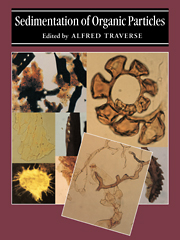Book contents
- Frontmatter
- Contents
- Editor's preface
- List of contributors
- I Introduction
- II Studies of palynosedimentation in modern environments
- 2 The sorting of spores and pollen by water: experimental and field evidence
- 3 Transport and deposition of pollen in an estuary: signature of the landscape
- 4 Pollen preservation in alkaline soils of the American Southwest
- 5 Wind and water transport and sedimentation of miospores along two rivers subject to major floods and entering the Mediterranean Sea at Calvi (Corsica, France)
- 6 Sedimentation of land-derived palynomorphs in the Trinity–Galveston Bay area, Texas
- 7 The genesis and sedimentation of phytoclasts with examples from coastal environments
- 8 Palynofacies of some recent marine sediments: the role of transportation
- 9 Maceral palynofacies of the Louisiana deltaic plain in terms of organic constituents and hydrocarbon potential
- 10 Organic sedimentation in a carbonate region
- 11 An approach to a standard terminology for palynodebris
- 12 Relationships of palynofacies to coal-depositional environments in the upper Paleocene of the Gulf Coast Basin, Texas, and the Powder River Basin, Montana and Wyoming
- III Reconstruction of late Cenozoic vegetation and sedimentary environments from palynological data
- IV Application of data on palynosedimentation to solution of geological problems
- V Appendix
- Index
4 - Pollen preservation in alkaline soils of the American Southwest
Published online by Cambridge University Press: 06 January 2010
- Frontmatter
- Contents
- Editor's preface
- List of contributors
- I Introduction
- II Studies of palynosedimentation in modern environments
- 2 The sorting of spores and pollen by water: experimental and field evidence
- 3 Transport and deposition of pollen in an estuary: signature of the landscape
- 4 Pollen preservation in alkaline soils of the American Southwest
- 5 Wind and water transport and sedimentation of miospores along two rivers subject to major floods and entering the Mediterranean Sea at Calvi (Corsica, France)
- 6 Sedimentation of land-derived palynomorphs in the Trinity–Galveston Bay area, Texas
- 7 The genesis and sedimentation of phytoclasts with examples from coastal environments
- 8 Palynofacies of some recent marine sediments: the role of transportation
- 9 Maceral palynofacies of the Louisiana deltaic plain in terms of organic constituents and hydrocarbon potential
- 10 Organic sedimentation in a carbonate region
- 11 An approach to a standard terminology for palynodebris
- 12 Relationships of palynofacies to coal-depositional environments in the upper Paleocene of the Gulf Coast Basin, Texas, and the Powder River Basin, Montana and Wyoming
- III Reconstruction of late Cenozoic vegetation and sedimentary environments from palynological data
- IV Application of data on palynosedimentation to solution of geological problems
- V Appendix
- Index
Summary
Introduction
Pollen analyses form the data base for many types of inferences ranging from sequential changes in past environments to lifestyles and diets of prehistoric human populations. In all cases, interpretation of pollen data must account for those factors that may have influenced the composition of the original pollen rain, and also for those factors that may have altered the composition of the pollen assemblage following deposition.
During the last 50 years palynologists have learned that there are many complex factors that determine the original composition of the pollen rain in an arid region. These include mode of pollination, differences in pollen production, differential dispersion patterns, and the size, weight, and aerodynamic ability of pollen types to remain airborne (see Chaps. 3, 13, 14, and other related chapters in this volume). Following deposition, other factors influence eventual loss or recovery of specific pollen types. These factors include pollen redeposition, the chemical composition of a pollen grain's exine, its morphological shape and types of surface ornamentation, and its susceptibility to various types of degradation processes including those from mechanical, chemical, or biological agents (Bryant, 1978, 1988; Bryant & Holloway, 1983; Hollo way, 1989; O'Rourke, 1990). In this chapter we focus on the post depositional degradation processes.
One of the first agents that can affect pollen grains is mechanical degradation. After pollen is released from its source, it can become abraded or broken during the transportation phase. These alterations can result from impact or from changes in the natural environment.
- Type
- Chapter
- Information
- Sedimentation of Organic Particles , pp. 47 - 58Publisher: Cambridge University PressPrint publication year: 1994
- 25
- Cited by



